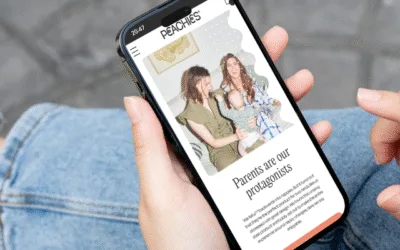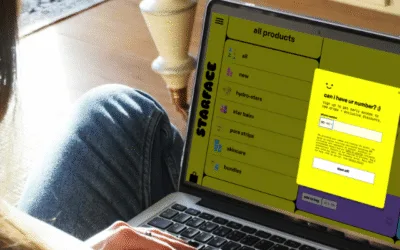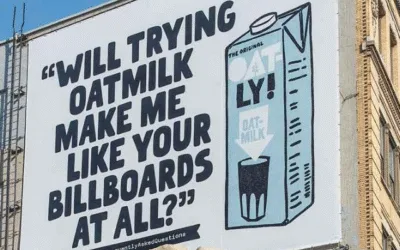Peachies beat Pampers by selling sleep, not nappies. Learn their Ladder of Why messaging trick to make your copy resonate.
How to flip cliches to write ads and copy like The Economist, VW and Taco Bell
Struggling to write scroll-stopping ads? Here’s how to steal a classic copy trick that’s backed by brain science and proven results.
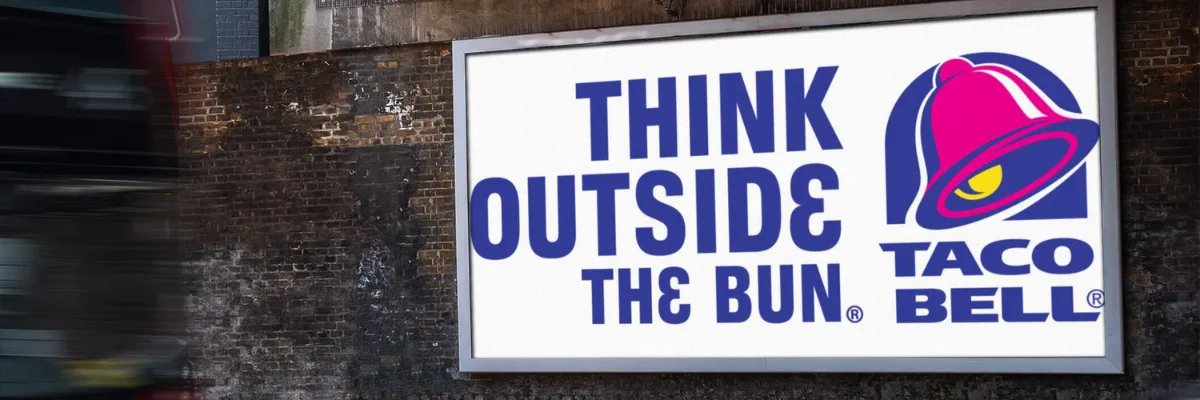
Get pro copy tips, branding tricks and e-comm insights directly to your inbox every Tuesday.
This week, we thought we’d dive into one of our favourite creative exercises for coming up with creative, scroll-stopping ad/top of funnel copy: taking a cliche and flipping it.
💡This week’s big idea: most people will tell you to avoid cliches in your writing. But if you’re clever, they’re a powerful tool to add to your copywriting toolbox.
A lot of copywriting advice (like avoid cliches) feels like a hangover from people that wanted to be novelists but had to turn their hands to copywriting instead.
(No shade there, this newsletter is written by two of them.)
And, to be fair, that kind of advice is great for when the writing is the point. If you’re writing a novel or a poem or a screenplay, clichés are your worst enemy.
But people choose to read poetry and books. They’re a captive audience, so you have their buy in to make their brains work a little.
Nobody actively chooses to read copy. (Well, unless you write a copy newsletter.)
And they definitely don’t want to actively think about your copy.And each time you write something that means a customer has to stop to process what you’re saying rather than passively absorbing it, you risk losing their attention for good.
That’s where cliches come into their own.
They’re so familiar to our brains and so easy to process that they let copywriters express complex ideas in a few words and keep readers reading. (Not to mention, making your copy easy to read makes your brand more likeable and more likely to convert.)
In fact, Gary Halbert, a copywriter recognised as the greatest direct response copywriter of the last century, used LOTS of cliches in his writing for that exact reason. (He loved using the phrase “easy as pie” in his sales letters.)
But there’s another way to use cliches that’s even better when you’re going after the holy grail of TOF copy: quick to “get”, easy to remember and stickiness.
And it’s been used in some of the most famous ad campaigns of all time.
Let’s dig into it 👇
How Volkswagen, Taco Bell and The Economist have used this clever technique to grab attention and stay memorable
This copywriting technique isn’t new at all. In fact, it’s been a copywriting staple for big brands looking to grab attention and challenge perception from the days of Mad Men through the 90s all the way to now.
Here it is in action to promote the Volkswagen Beetle in the 1960s 👇
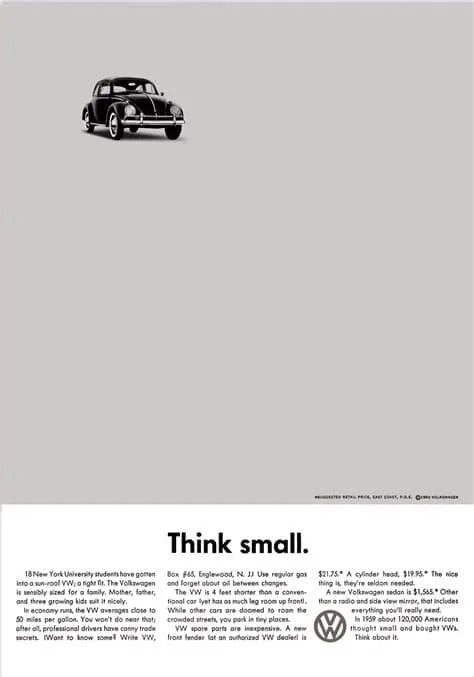
And here it is promoting The Economist in the mid-90s 👇

And here it is again promoting Taco Bell’s launch in the early 2000s👇
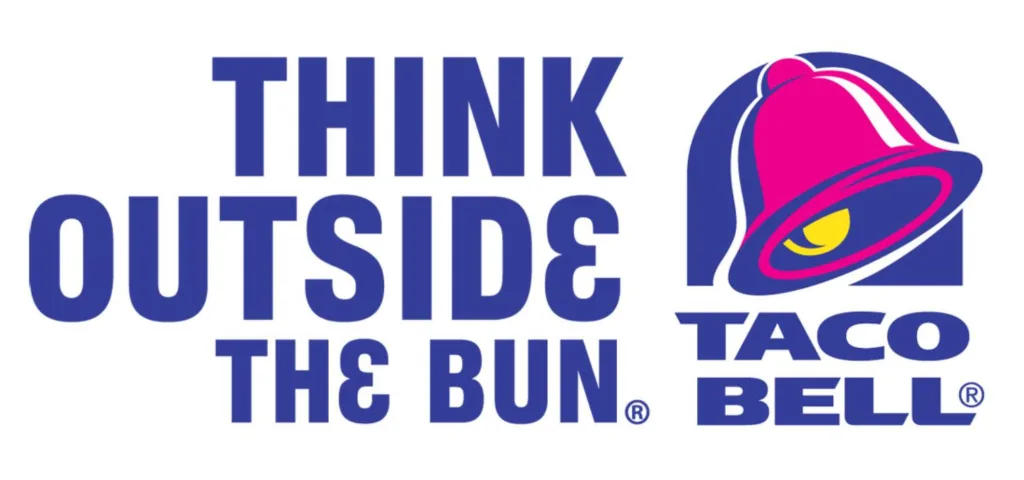
See how each of them takes a cliche that is already packed with meaning and then subverting it or twisting it a little to add new meaning?
It’s super smart and super effective. And there’s a load of under-the-hood brain science going on to make it work 👇
👉 They all start with an expression we immediately understand. As we know, our brains love things that are easy, so these brands all choose phrases we immediately “get”.
But there’s more than that too, because these cliches are actually bait on the line, hooking the reader into reading something “easy” and making them think they know where the copy is going.
👉 Then, the copy takes an unexpected twist. That sharp left-turn to somewhere new and unexpected creates something called a prediction-error jolt in our brains.
Your brain going “huh, that didn’t say what I thought it was going to say” triggers a “I need to remember that” signal (called a reward-prediction-error signal).
In other words, the twist makes our brains unable to not pay attention to the copy. Plus, that element of surprise also helps the message stick. Studies show that prediction errors make our brains rewire themselves and commit the new information to memory.
👉 The clever payoff creates a quick dopamine hit in our brains. That little click! moment where our brains reconcile the twist with the new meaning is called an “aha moment”.
fMRI scans show that our brain’s reward circuitry fires on all cylinders when this happens. In other words, we feel good about ourselves and those feel goods transfer over to how we feel about your brand.
(This has been studied and proven to shift attitudes towards brands, making customers feel more positively towards brands and products.)
But it’s not just clever brain science. It moves the bottom line needle, too.
Let’s jump back to that Taco Bell ad.
In the early 2000s, Taco Bell was having a bit of a crisis of identity.
Despite the fact they were becoming a major player in the US fast-food industry, they were still constantly being lumped into the same conversation as burger joints. Most consumers didn’t see it as a Mexican fast food place, they saw it as another fast food place.
As such, their big guac-covered USP was getting completely lost in the noise.
But in 4 words, they managed to change that.
How? By swapping the word box → bun, Taco Bell managed to reframe the idea of getting a “burger” as the boring, predictable, meh option.
But tacos? They were the more inspired choice. The choice that showed that you weren’t a sheep. The choice that’s outside of the fast food crowd altogether.
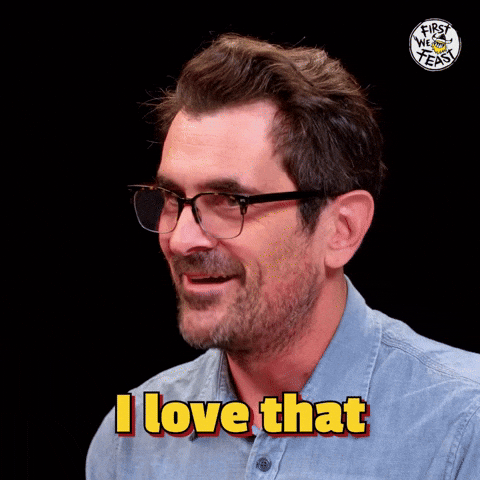
The result? Despite years of flat or falling results, the “Think Outside the Bun” campaign reversed the slide. Within a few months, same‑store sales were up 8%. Over the following year, brand‑wide sales grew ~6% YOY.
Not bad for changing one word of a cliche, huh?
How to put this to work for your brand
Let’s be honest, top of funnel copy is hard work.
You have a tiny, minuscule amount of time to pack in so much information AND make sure it’s memorable, hooky, scroll-stopping, on-brand…
That’s why this trick is a great one to have in your toolbox.
Cliches, by their nature, are Pandora’s boxes of meaning. And adding a meaning flip on top doubles down on that.
(Not to mention, these clever cliche flips always feel expensive and like they’ve been written by an ad agency. And when we know customers like to buy from brands that seem like they’re investing money on their marketing, having agency-level copy becomes a trust-marker.)
So, here’s how to DIY some killer cliche-flipping copy for your brand 👇
Step 1: Find a familiar saying that is related to your main message
Now, we’ve been using the term cliches so far, but you don’t necessarily have to pick a cliche. You can use idioms. You can use famous movie taglines. You can even use song lyrics. (Although, copyright law gets a bit dicey on those.)
The trick is to find a saying people immediately recognise that’s related to the USP you want to highlight.
So write down any cliches, phrases or memorable lines you can think of.
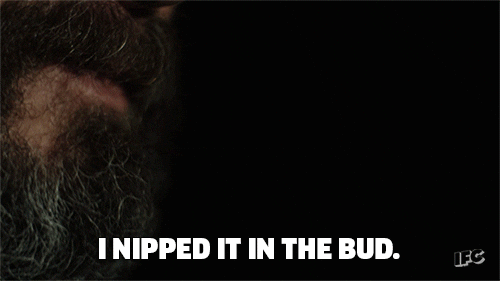
At this stage, the more the merrier. You never know where and when inspiration is going to strike.
Remember to zoom out on the theme, too.
If your main message is focused around speed, remember that speed isn’t just about saving the customers time, it’s about impatience, hunger, FOMO, instant gratification, getting a task done there and then…
What idioms or cliches can you find related to those things as well? That’s often where the gold is.
👋 Pro tip: look for idioms that say the opposite thing to whatever you’re trying to say. That makes the next step super easy.
So if you’re selling based on speed, look for comments about things being slow or taking a long time or being worth the wait.
Step 2: Look for a way to flip the meaning
Now, we’re onto the fun bit.
Scanning down our list of phrases, we need to find a way flip the meaning so that it says something new and emphasizes your brand’s USPs.
We like to do this by swapping out words, adding on extra lines or finding a way to swap one of the words for a rhyme.
However you want to do it, you need to make sure you do three things:
1) The cliche/idiom needs to remain immediately recognizable. If not, the whole thing is kaput.
2) Your USP or benefit needs to be immediately clear too. Making them think for a split second is OK (it’s part of the beauty of this technique, actually) but turning it into a puzzle defeats the point.
3) The twist needs to reinforce your positioning. Clever for the sake of clever doesn’t work.
But that all sounds a bit academic and dry.
In reality, it’s a lot more fun and creative than that. Check it out 👇
Let’s put it to work on a brief together
Imagine you’ve been asked to write some top of funnel/awareness campaign copy that can run on social media and possibly an OOH campaign. Your client is Entropy, a D2C coffee brand that positions itself as a one-stop-shop for coffee lovers.
Their audience, however, aren’t baristas or coffee purists, they’re busy professionals that love good coffee. They don’t necessarily have the time to order from local roasters. And they’re definitely not spending time before they go to work weighing their coffee. But, they also see themselves as different and place value on their identity as a “drinker of good coffee” compared to getting their name misspelled on a takeaway cup.
So we need an ad that speaks to speed/convenience, identity and quality.
Now, it’s time to play around with those idioms.
Speed is the easiest element to find an idiom/cliche for. (Just think of how many ways we have of describing things being quick in our day-to-day lives.) It makes sense to start there and see if we can bake in the identity and quality angles.
So, we get started jotting down as many speed-related phrases as we can think of👇
- In a jiffy
- At the drop of a hat
- In a heartbeat
- In a New York minute
- Two shakes of a lamb’s tail
- In 30 seconds flat
- The early bird catches the worm
There’s not really anything there to work with.
Sure, we could do “Coffee ready in 30 seconds flat (white)” but that’s just a pun for pun’s sake. It doesn’t add meaning.
So, let’s zoom out.
Let’s find phrases that say the opposite and flip them.
Something like “You can’t hurry love. But you can hurry your morning brew”. It’s heading in the right direction, but it’s still a bit meh.
What about “Good things come to those who wait.”
What if we flipped that? 👇
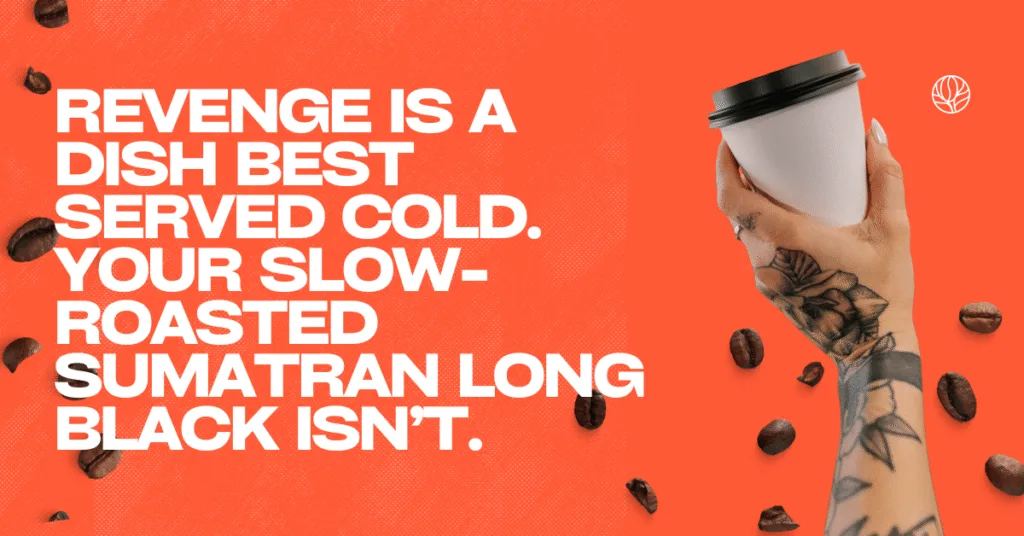
That copy is really pretty decent.
It twists the cliche and speaks to their identity as a busy coffee drinker. That’s two big wins.
However, there is an argument that highlighting the speed like this undermines the quality of the coffee. This feels like a line McDonalds or Starbucks or another fast coffee chain could run about their coffee too.
And that’s the opposite of what we’re going for.
So we go back to the drawing board.
Instead, what if we go one step further and play not just into more coffee-specific language, but dial up the identity angle too? Play into that chain coffee vs home brew rivalry a bit?
But how do we do that? Let’s play around with the last word of our cliche and see if we can swap out the word “wait” for a coffee-related word that ends in an “ate” sound.
(Bonus: this lets us stack wins by adding in the Rhyme as Reason bias, which is where our brains trust, like and remember copy better when it rhymes.)
And if we do that, we get something like this 👇
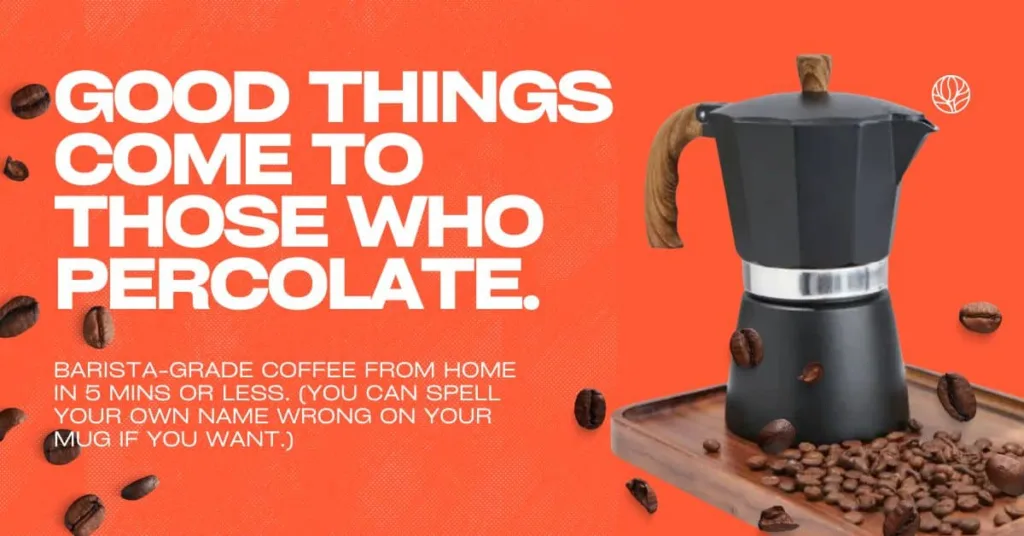
Much better fit for their audience, right?
The cliche flip grabs attention and ticks all the brain science boxes while the wait → percolate speaks to speed/convenience, identity and quality.
Sure, we’re not saying it’s fast, but we’re implying it’s worth the wait and still faster, tastier and more aligned with their identity than a chain coffee.
Likewise, if Entropy also sold branded thermal travel mugs, we could go with a cliche flip like this 👇
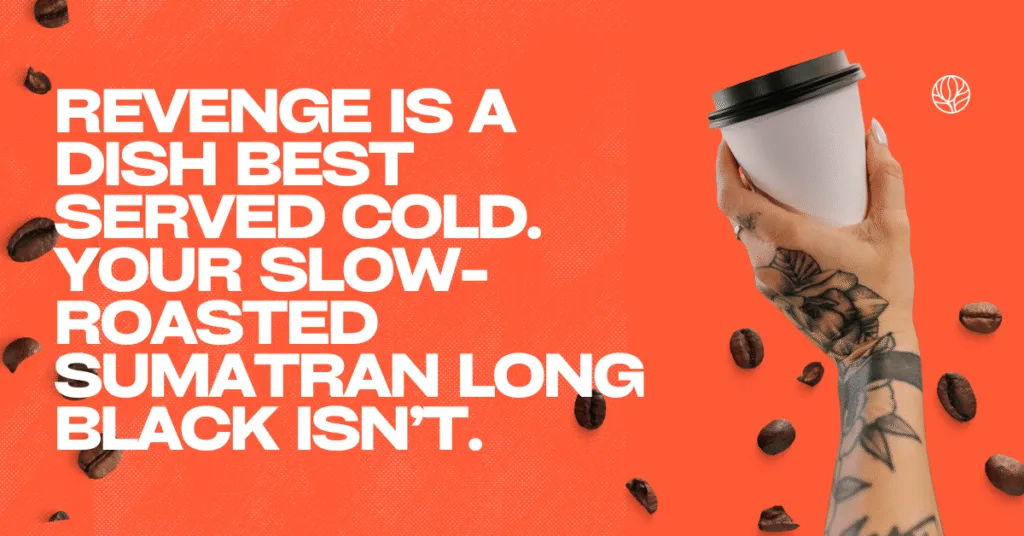
Remember when we said to look for idioms and cliches that say the opposite thing? This is why.
We don’t need to use any clever rhyming or wordplay here. Just a simple rebuttal of a cliche mixed with a tiny bit of “we get you” language and we’re cooking.
(Side note: see how “slow-roasted Sumatran long black” is more compelling than “your morning cup of Joe”. That’s the difference concrete, sensory details can make to your copy.)
Now, compare this copy to something like “Thermal cups that keep your coffee warm from 9 until 5”. This is far more memorable, hooky and likely to stop your scroll, right?
And best of all? There’s barely any actual “writing” to do at all.
And this week, we 💛 a quick, lazy copywriting win.
Need a hand figuring out some clever top of funnel copy? Feel like your headlines need a bit more oomph? Need to update your website copy or brand voice? We’d love to help. Grab a slot on our calendar and we’ll have a chat about how we can help. (No pressure, no hard-sell BS.)
Dive into more free tips and tricks 👇
How Starface use orthography to build a killer brand voice their customers love
The words you write matter. But so do your full stops, emojis and lowercase letters. Learn how to turn punctuation into a powerful part of your brand voice.
Why Oatly’s brand voice is so damn good (and how yours can be, too)
We dig into the three layers of brand voice (10,000ft, 1,000ft, ground level), show how Oatly nails each one and how you can do it for your own brand.
The weekly newsletter that takes your brand’s copy from “meh” to “hell f*cking yeah!”
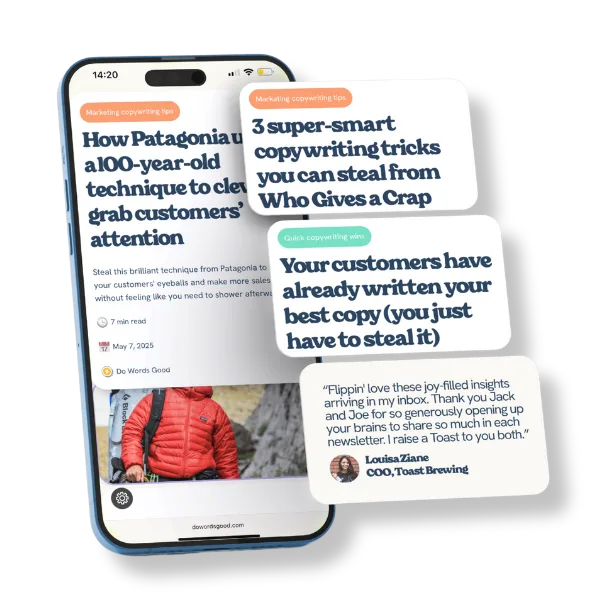
Read every week by legends at brands like these











